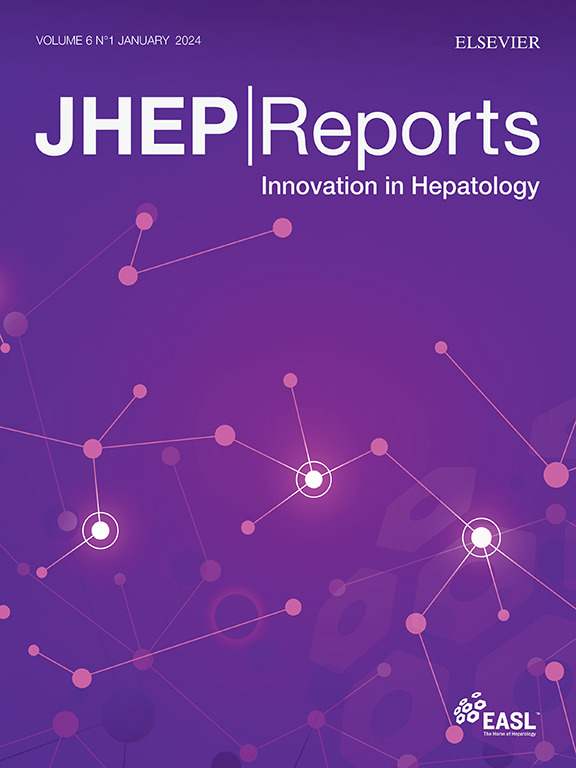Incidence and mortality of alcohol-related hepatitis in Denmark – an update, 2016–2023
IF 9.5
1区 医学
Q1 GASTROENTEROLOGY & HEPATOLOGY
引用次数: 0
Abstract
Background & Aims
Alcohol-related hepatitis (AH) is a severe liver disease associated with high mortality. This study provides data on the incidence and mortality of AH in Denmark from 2016 to 2023.
Methods
We identified all patients with a first-time hospital discharge diagnosis of AH and a serum bilirubin level >3 mg/dl in 2016–2023. We computed the standardized incidence rate of AH in the Danish population and mortality from admission with AH. We compared the results to our previously published findings for the 1999-2008 period.
Results
We included 1,016 patients with a median age of 54.7 years (66% men). The standardized incidence rate was 21.7 per million per year, which remained stable during the study period for both men and women. Mortality was high: 18% at 28 days, 26% at 84 days, and 40% at 365 days. Although 28-day and 84-day mortality risks were lower in 2023 compared to earlier years, no overall trend of improvement was observed. The median MELD score at admission, available for 846 patients, was consistently high at 26, and 75% had severe AH (MELD >21). Compared to an incidence rate of approximately 45 per million per year in 2009, the incidence of AH has since decreased dramatically, mirroring Danish alcohol sales.
Conclusions
The incidence of AH in Denmark markedly declined from 2009 but stabilized between 2016 and 2023. Mortality remains high, emphasizing the need for better treatment strategies.
Impact and implications
This study investigated the incidence and mortality of alcohol-related hepatitis (AH) in Denmark from 2016 to 2023, providing updated data in the context of declining alcohol consumption. While AH incidence has decreased since 2009, mirroring reduced alcohol intake, it has stabilized in recent years, and mortality remains high. These findings highlight the ongoing burden of AH for healthcare providers, researchers, and policymakers. Our results can support early interventional strategies, guide clinical management, and reinforce public health efforts to reduce alcohol consumption. Limitations, such as the lack of detailed treatment data, should be considered to avoid overgeneralization.
2016-2023年丹麦酒精相关肝炎发病率和死亡率最新情况
背景,酒精相关性肝炎(AH)是一种高死亡率的严重肝脏疾病。本研究提供了2016年至2023年丹麦AH发病率和死亡率的数据。方法选取2016-2023年首次出院诊断为AH且血清胆红素水平≤3mg /dl的所有患者。我们计算了丹麦人群中AH的标准化发病率和入院时AH的死亡率。我们将结果与之前发表的1999-2008年期间的研究结果进行了比较。结果纳入1016例患者,中位年龄54.7岁(66%为男性)。标准化发病率为每年每百万人21.7例,在研究期间,这一数字对男性和女性都保持稳定。死亡率很高:28天时为18%,84天时为26%,365天时为40%。尽管与前几年相比,2023年的28天和84天死亡率风险较低,但没有观察到总体改善趋势。入院时,846例患者的中位MELD评分一直很高,为26分,75%患有严重AH (MELD >21)。与2009年每年约45 /百万人的发病率相比,此后AH的发病率急剧下降,这反映了丹麦酒精销售的情况。结论丹麦AH的发病率从2009年开始明显下降,但在2016 - 2023年期间趋于稳定。死亡率仍然很高,强调需要更好的治疗策略。影响和意义本研究调查了2016年至2023年丹麦酒精相关性肝炎(AH)的发病率和死亡率,在酒精消费量下降的背景下提供了最新数据。虽然自2009年以来AH发病率有所下降,反映了酒精摄入量的减少,但近年来一直稳定,死亡率仍然很高。这些发现突出了对医疗保健提供者、研究人员和政策制定者的持续负担。我们的研究结果可以支持早期干预策略,指导临床管理,并加强公共卫生努力,以减少酒精消费。局限性,如缺乏详细的治疗数据,应考虑,以避免过度概括。
本文章由计算机程序翻译,如有差异,请以英文原文为准。
求助全文
约1分钟内获得全文
求助全文
来源期刊

JHEP Reports
GASTROENTEROLOGY & HEPATOLOGY-
CiteScore
12.40
自引率
2.40%
发文量
161
审稿时长
36 days
期刊介绍:
JHEP Reports is an open access journal that is affiliated with the European Association for the Study of the Liver (EASL). It serves as a companion journal to the highly respected Journal of Hepatology.
The primary objective of JHEP Reports is to publish original papers and reviews that contribute to the advancement of knowledge in the field of liver diseases. The journal covers a wide range of topics, including basic, translational, and clinical research. It also focuses on global issues in hepatology, with particular emphasis on areas such as clinical trials, novel diagnostics, precision medicine and therapeutics, cancer research, cellular and molecular studies, artificial intelligence, microbiome research, epidemiology, and cutting-edge technologies.
In summary, JHEP Reports is dedicated to promoting scientific discoveries and innovations in liver diseases through the publication of high-quality research papers and reviews covering various aspects of hepatology.
 求助内容:
求助内容: 应助结果提醒方式:
应助结果提醒方式:


